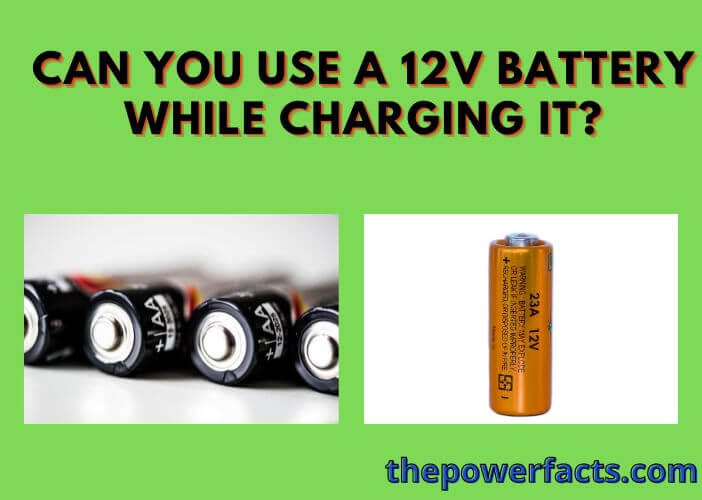Published on: June 13, 2023
Written by Jonas Frank / Fact-checked by Nova Scarlett
Welcome to the intriguing world of 12V batteries! Whether you’re a professional technician or a curious individual, the question “Can you use a 12V battery while charging it?” has probably crossed your mind. Let’s explore the answer to this battery conundrum, and more, in the upcoming sections.

Can You Use a 12V Battery While Charging It: An In-depth Analysis
Let’s not beat around the bush: yes, you can use a 12V battery while it’s being charged. But the real question is, should you? Dive in as we unpack the complexities of simultaneous battery usage and charging.
Understanding Battery Chemistry
To truly appreciate the answer, we need to delve into the depths of battery chemistry. 12V batteries, commonly known as lead-acid batteries, operate on the fundamental principle of reversible chemical reactions. This means that they discharge energy when in use and reverse the chemical process when charged, allowing for multiple cycles of use.
The Charging-Discharging Balance
When a 12V battery is both used and charged simultaneously, it maintains a delicate balance between the charging and discharging processes. The charger provides extra power, ensuring the load draws from it instead of depleting the battery’s stored energy.
Safety Measures: Using and Charging Simultaneously
While it’s technically feasible to use a 12V battery while charging it, we must consider some crucial safety measures.
The Role of Regulated Chargers
A regulated charger is an unsung hero in this tale. It manages the voltage levels during the charging process, ensuring the battery doesn’t overcharge. Thus, it’s crucial to use one if you’re planning to use the battery while charging.
Keeping the Heat in Check
Batteries can heat up during charging, and usage can exacerbate this. Keep an eye on the battery temperature, ensuring it doesn’t exceed safe levels. Excessive heat can damage the battery and might even pose a fire hazard.
Challenges When Using a 12V Battery While Charging
While possible, using a 12V battery while charging it isn’t always smooth sailing. Let’s look at some of the potential roadblocks.
Reduced Battery Lifespan
Simultaneous usage and charging can contribute to faster battery wear, potentially reducing its lifespan. This could lead to the need for more frequent battery replacements.
Voltage Fluctuations
Voltage fluctuations are another concern. Using the battery while it charges might cause an uneven power supply, affecting the performance of the connected devices.
Potential Applications: Simultaneous Usage and Charging
In some instances, using a 12V battery while charging it can be quite practical. Let’s look at some of the scenarios where this is applicable.
Solar Power Systems
Solar power systems often use 12V batteries for energy storage. In such systems, it’s common to use the battery power during the day while the solar panels recharge the battery simultaneously.
Uninterruptible Power Supply (UPS) Systems
In UPS systems, the 12V battery provides power during outages, but it’s continuously charged when the main power supply is available. This ensures the battery is always ready to supply power when needed.
Frequently Asked Questions (FAQs)
Can I use a 12V battery while charging it?
Yes, it’s technically possible to use a 12V battery while charging it. However, this should be done under the right conditions and with appropriate safety measures to prevent any potential harm or damage to the battery.
Will using a 12V battery while charging it damage the battery?
There’s a risk of damaging the battery if not managed properly. Overheating and overcharging are the main risks. Always use a regulated charger and monitor the battery temperature.
What are the benefits of using a 12V battery while charging it?
In certain applications like solar power systems and UPS systems, simultaneous usage and charging can ensure a consistent power supply and efficient use of generated energy.
What are the drawbacks of using a 12V battery while charging it?
Simultaneous usage and charging can contribute to faster battery wear and reduced lifespan. It may also cause voltage fluctuations, affecting the performance of connected devices.
Is it safe to use a 12V battery while charging it?
Safety largely depends on how you manage the charging process. Using a regulated charger and monitoring the battery’s temperature are critical safety measures.
Can using and charging a 12V battery simultaneously impact its longevity?
Yes, the simultaneous usage and charging can lead to faster battery wear, potentially reducing its lifespan.
Conclusion: The Verdict on Using a 12V Battery While Charging It
So, can you use a 12V battery while charging it? Yes, but with some caveats. Understanding the nuances involved in this process and employing appropriate safety measures are crucial. While it offers benefits in some applications, it’s not a one-size-fits-all solution. Ultimately, it’s up to you to weigh the pros and cons based on your specific needs and usage scenarios.
